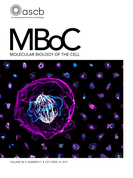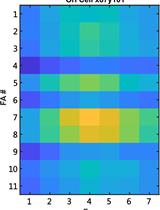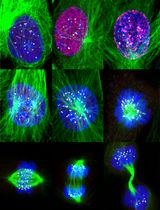- EN - English
- CN - 中文
Tracking Endocytosis and Intracellular Trafficking of Epitope-tagged Syntaxin 3 by Antibody Feeding in Live, Polarized MDCK Cells
通过抗体喂养追踪活体极化MDCK细胞中表位标记的 Syntaxin 3的胞吞作用和细胞内转运
发布: 2018年02月05日第8卷第3期 DOI: 10.21769/BioProtoc.2453 浏览次数: 9484
评审: Gal HaimovichAlexandros KokotosAnonymous reviewer(s)

相关实验方案
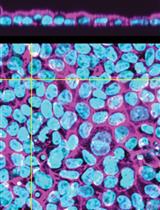
自动层次分析(ALAn):用于无偏见表征培养中哺乳动物上皮结构的图像分析工具
Christian Cammarota [...] Tara M. Finegan
2024年04月20日 4183 阅读
Abstract
The uptake and trafficking of cell surface receptors can be monitored by a technique called ‘antibody-feeding’ which uses an externally applied antibody to label the receptor on the surface of cultured, live cells. Here, we adapt the traditional antibody-feeding experiment to polarized epithelial cells (Madin-Darby Canine Kidney) grown on permeable Transwell supports. By adding two tandem extracellular Myc epitope tags to the C-terminus of the SNARE protein syntaxin 3 (Stx3), we provided a site where an antibody could bind, allowing us to perform antibody-feeding experiments on cells with distinct apical and basolateral membranes. With this procedure, we observed the endocytosis and intracellular trafficking of Stx3. Specifically, we assessed the internalization rate of Stx3 from the basolateral membrane and observed the ensuing endocytic route in both time and space using immunofluorescence microscopy on cells fixed at different time points. For cell lines that form a polarized monolayer containing distinct apical and basolateral membranes when cultured on permeable supports, e.g., MDCK or Caco-2, this protocol can measure the rate of endocytosis and follow the subsequent trafficking of a target protein from either limiting membrane.
Keywords: Antibody-feeding assay (抗体喂养试验)Background
The SNARE protein Syntaxin 3 (Stx3) is known to establish apical-basolateral polarity in polarized epithelial cells (Low et al., 1996; Delgrossi et al., 1997; Weimbs et al., 1997; Low et al., 1998; Li et al., 2002; Low et al., 2006). Apical localization of Stx3 depends on a conserved targeting motif near the N-terminus of the protein (ter Beest et al., 2005; Sharma et al., 2006). A fraction of Stx3 is also known to localize to late endosomes/lysosomes in Madin-Darby Canine Kidney (MDCK) cells, which form tight-junctions, establish apical and basolateral polarity, and adopt a columnar morphology when grown to confluence. To determine the origin of this population of Stx3 and to investigate its endosomal trafficking in polarized MDCK cells, we designed an ‘antibody-feeding assay’ protocol. Using this assay and other experiments, we have shown that Stx3 is ubiquitinated at lysine residues in a basic juxtamembrane region and that ubiquitination facilitates the endocytosis of Stx3 from the basolateral membrane leading to trafficking to intraluminal vesicles of multivesicular bodies, and eventually secretion with exosomes (Giovannone et al., 2017). A non-ubiquitinatable mutant (Stx3-5R) exhibits decreased endosomal trafficking and exosomal secretion (Giovannone et al., 2017). Using an antibody-feeding assay, we can monitor where Stx3 is trafficked after being delivered to the apical or basolateral membrane. A cassette containing two Myc epitope tags and one hexa-histidine tag was added to the C-terminus of Stx3 by molecular cloning. These tags are exposed to the extracytoplasmic side of the plasma membrane when tagged Stx3 is present on the surface in transfected cells. We have previously shown that these C-terminal Myc2-His6 tags are accessible to the 9E10 anti-c-Myc monoclonal antibody and do not interfere with the known surface polarity of several syntaxins (Low et al., 2000; Kreitzer et al., 2003; Low et al., 2006; Sharma et al., 2006; Reales et al., 2011; Giovannone et al., 2017). Epitope-tagged Stx3 is stably expressed in MDCK cells using a tetracycline-controlled transcriptional activation system which allows using uninduced cells as a negative control. Cells are cultured on Transwell permeable membranes until fully polarized (Figure 1), incubated with anti-c-Myc antibody, and harvested for analysis by immunofluorescence microscopy at various time points. Cells were also incubated with anti-M6PR antibody (late endosomal marker). Lastly, cells were stained with DAPI and secondary antibodies against the 9E10 anti-c-Myc monoclonal antibody (for Stx3) and anti-M6PR antibody. 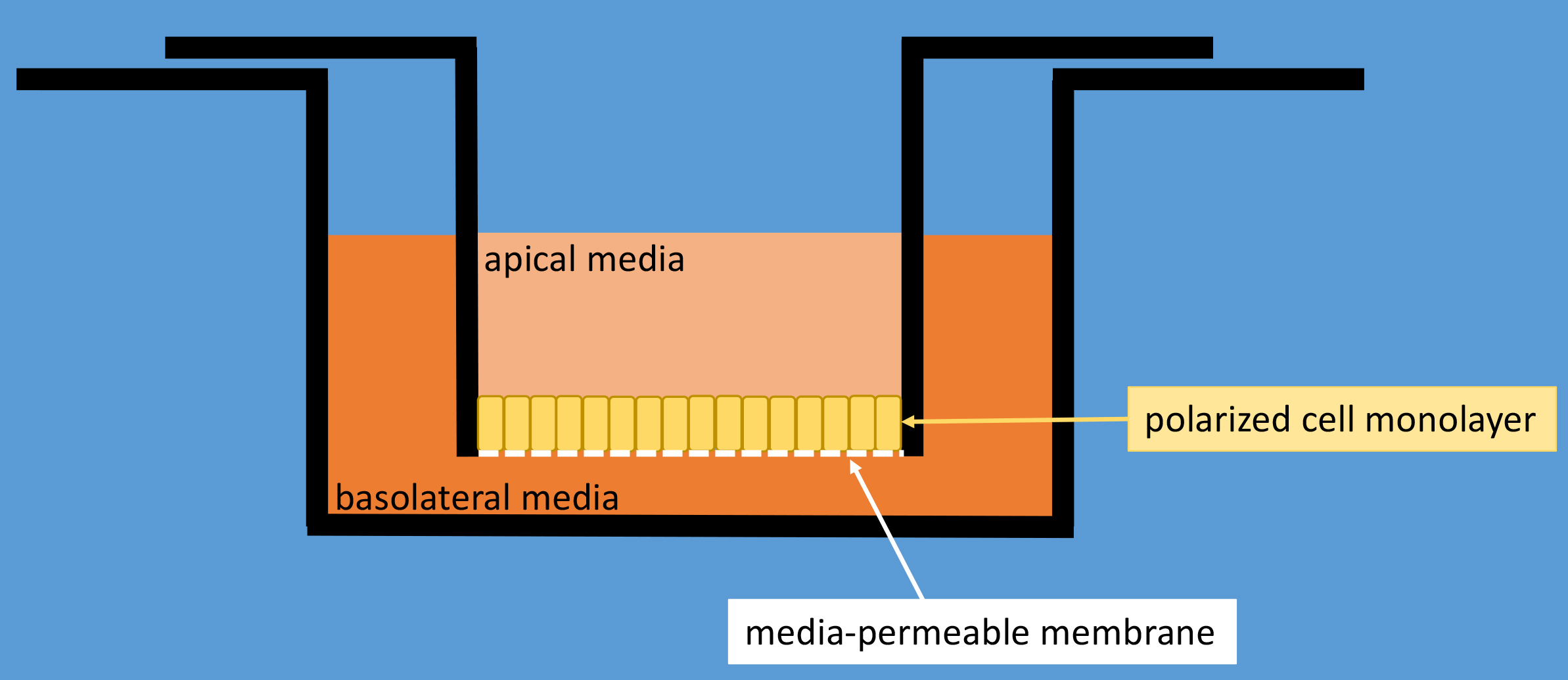
Figure 1. Schematic drawing of a Transwell polycarbonate membrane cell culture insert inside a well of a typical 12-well cell culture dish. Cells are cultured on top of the membrane and will form a tight monolayer that seals off the polycarbonate membrane thereby separating the apical media compartment from the basolateral media compartment.
Materials and Reagents
- 10 cm cell culture dishes (Corning, Falcon®, catalog number: 353003 )
- 10 ml serological pipette (VWR, catalog number: 89130-898 )
- 50 ml conical tubes (Corning, catalog number: 430290 )
- 12-well cell culture plates with 0.4 µm pore polycarbonate Transwell supports (Corning, catalog number: 3401 )
- 12-well cell culture plates (Corning, Costar®, catalog number: 3512 )
- Razor blades (VWR, catalog number: 55411-050 )
- Paper towels
- Kimwipes (KCWW, Kimberly-Clark, catalog number: 34120 )
- Parafilm (BEMIS, catalog number: PM996 )
- Plastic pencil box with lid (VWR, catalog number: 500003-109 )
Manufacturer: Janitorial Supplies, catalog number: AVT34104 . - Microscope slides (any standard slides from any supplier will be fine)
- Micro cover glasses, 18 x 18 mm, No. 1 thickness is 0.13 to 0.17 mm (VWR, catalog number: 48366-045 )
- Madin-Darby Canine Kidney (MDCK) cells stably expressing C-terminally Myc2-His6-tagged Stx3
Note: Madin-Darby Canine Kidney (MDCK) cells stably expressing C-terminally Myc2-His6-tagged Stx3 using a doxycycline-inducible expression system have been described in detail in Sharma et al., 2006. The parental cell line, expressing the TET transactivator is required to produce doxycycline-inducible, stably transfected cells for one’s gene of interest and have been generated in the laboratory of the senior author (TW). Cells may be requested from the authors. Original MDCK cells and several subclones are also available from ATCC (ATCC, catalog number: CCL-34 and others) but these cells may differ in some characteristics from those used here. - Sterile 1x Dulbecco’s phosphate buffered saline (DPBS) without calcium or magnesium (Mediatech, catalog number: 21-031-CV )
- Sterile 0.25% trypsin/EDTA (Mediatech, catalog number: 22-053-CI )
- 4% buffered formalin solution (Sigma-Aldrich, catalog number: HT5012 )
- Prolong Gold anti-fade reagent plus DAPI (Thermo Fisher Scientific, InvitrogenTM, catalog number: P36934 )
- Sterile Minimum Essential Medium without glutamine (Mediatech, catalog number: 15-010-CV )
- Sterile L-glutamine 100x (Mediatech, catalog number: 25-005-CI )
- Penicillin/Streptomycin 100x (Mediatech, catalog number: 30-002-CI )
- Fetal bovine serum (FBS) (Omega Scientific, catalog number: FB-11 )
- Doxycycline monohydrate (tetracycline analog) (Sigma-Aldrich, catalog number: D1822 )
- HEPES (Fisher Scientific, catalog number: BP310 )
- Bovine serum albumin (BSA) (Sigma-Aldrich, catalog number: A2153 )
- Anti-c-Myc monoclonal antibody, clone 9E10
Note: Hybridoma cells from The Developmental Studies Hybridoma Bank (http://dshb.biology.uiowa.edu). Prepare mouse ascites using a commercial vendor. - Ammonium chloride (NH4Cl) (Sigma-Aldrich, catalog number: A5666 )
Note: This product has been discontinued. - L-glycine (Fisher Scientific, catalog number: BP381-5 )
- Normal Donkey serum (LAMPIRE Biological Labs, catalog number: 7332100 )
- Triton X-100 (Fisher Scientific, catalog number: BP151-500 )
- Mannose-6-Phosphate Receptor antibody (kind gift from William Brown, Cornell University)
- Fish skin gelatin (Sigma-Aldrich, catalog number: G7765 )
- Donkey anti-mouse DyLight 488 (Jackson ImmunoResearch Laboratories, catalog number: 715-485-150 )
Note: This product has been discontinued. - Donkey anti-rabbit DyLight 594 (Jackson ImmunoResearch Laboratories, catalog number: 711-515-152 )
Note: This product has been discontinued. - Complete media (see Recipes)
- Serum-free media (see Recipes)
- 1 mg/ml doxycycline stock solution (see Recipes)
- MEM ETC (see Recipes)
- MEM ETC containing anti-c-Myc antibody (see Recipes)
- Quench solution (see Recipes)
- Block and Permeabilization buffer (see Recipes)
- Primary antibody solution (see Recipes)
- Washing solution (see Recipes)
- Secondary antibody solution (see Recipes)
Equipment
- BSL-2 hood (Nuaire, class II)
- Tissue culture incubator at 37 °C and 5% CO2 (Thermo Fisher Scientific, Thermo ScientificTM, model: HeracellTM 150 )
- Orbital shaker (Bellco)
- Hemocytometer (Hausser Scientific, catalog number: 3200 )
- Surgical scissors 140 mm (Dunrite Instruments, catalog number: 140940 )
- Dissecting forceps, fine tip, non-serrated
- Olympus Fluoview FV1000S (Olympus, model: Fluoview FV1000 ) Spectral Laser Scanning Confocal microscope using an Olympus UPLFLN 60x oil-immersion objective
- Cold room (4 °C)
Software
- Adobe Photoshop (Adobe Systems Inc.)
Procedure
文章信息
版权信息
© 2018 The Authors; exclusive licensee Bio-protocol LLC.
如何引用
Giovannone, A. J., Reales, E., Bhattaram, P., Fraile-Ramos, A. and Weimbs, T. (2018). Tracking Endocytosis and Intracellular Trafficking of Epitope-tagged Syntaxin 3 by Antibody Feeding in Live, Polarized MDCK Cells. Bio-protocol 8(3): e2453. DOI: 10.21769/BioProtoc.2453.
分类
细胞生物学 > 细胞成像 > 固定细胞成像
您对这篇实验方法有问题吗?
在此处发布您的问题,我们将邀请本文作者来回答。同时,我们会将您的问题发布到Bio-protocol Exchange,以便寻求社区成员的帮助。
Share
Bluesky
X
Copy link


